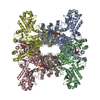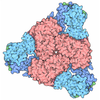[English] 日本語
 Yorodumi
Yorodumi- PDB-7wad: Trichodesmium erythraeum cyanophycin synthetase 1 (TeCphA1) with ... -
+ Open data
Open data
- Basic information
Basic information
| Entry | Database: PDB / ID: 7wad | |||||||||
|---|---|---|---|---|---|---|---|---|---|---|
| Title | Trichodesmium erythraeum cyanophycin synthetase 1 (TeCphA1) with ATPgammaS | |||||||||
 Components Components | Cyanophycin synthase | |||||||||
 Keywords Keywords |  LIGASE / LIGASE /  Cyanophycin / Cyanophycin /  Non-ribosomal peptide synthesis / Non-ribosomal peptide synthesis /  ATP / ATP /  Aspartate / Aspartate /  Arginine Arginine | |||||||||
| Function / homology |  Function and homology information Function and homology information cyanophycin synthase (L-aspartate-adding) / cyanophycin synthase (L-aspartate-adding) /  cyanophycin synthase (L-arginine-adding) / cyanophycin synthetase activity (L-aspartate-adding) / cyanophycin synthetase activity (L-arginine-adding) / cyanophycin synthase (L-arginine-adding) / cyanophycin synthetase activity (L-aspartate-adding) / cyanophycin synthetase activity (L-arginine-adding) /  tetrahydrofolylpolyglutamate synthase activity / macromolecule biosynthetic process / tetrahydrofolylpolyglutamate synthase activity / macromolecule biosynthetic process /  ATP binding / ATP binding /  metal ion binding metal ion bindingSimilarity search - Function | |||||||||
| Biological species |   Trichodesmium erythraeum IMS101 (bacteria) Trichodesmium erythraeum IMS101 (bacteria) | |||||||||
| Method |  ELECTRON MICROSCOPY / ELECTRON MICROSCOPY /  single particle reconstruction / single particle reconstruction /  cryo EM / Resolution: 2.96 Å cryo EM / Resolution: 2.96 Å | |||||||||
 Authors Authors | Kawasaki, M. / Miyakawa, T. / Yang, J. / Adachi, N. / Fujii, A. / Miyauchi, Y. / Muramatsu, T. / Moriya, T. / Senda, T. / Tanokura, M. | |||||||||
| Funding support |  Japan, 2items Japan, 2items
| |||||||||
 Citation Citation |  Journal: Nat Commun / Year: 2022 Journal: Nat Commun / Year: 2022Title: Structural bases for aspartate recognition and polymerization efficiency of cyanobacterial cyanophycin synthetase. Authors: Takuya Miyakawa / Jian Yang / Masato Kawasaki / Naruhiko Adachi / Ayumu Fujii / Yumiko Miyauchi / Tomonari Muramatsu / Toshio Moriya / Toshiya Senda / Masaru Tanokura /   Abstract: Cyanophycin is a natural biopolymer consisting of equimolar amounts of aspartate and arginine as the backbone and branched sidechain, respectively. It is produced by a single enzyme, cyanophycin ...Cyanophycin is a natural biopolymer consisting of equimolar amounts of aspartate and arginine as the backbone and branched sidechain, respectively. It is produced by a single enzyme, cyanophycin synthetase (CphA1), and accumulates as a nitrogen reservoir during N fixation by most cyanobacteria. A recent structural study showed that three constituent domains of CphA1 function as two distinct catalytic sites and an oligomerization interface in cyanophycin synthesis. However, it remains unclear how the ATP-dependent addition of aspartate to cyanophycin is initiated at the catalytic site of the glutathione synthetase-like domain. Here, we report the cryogenic electron microscopy structures of CphA1, including a complex with aspartate, cyanophycin primer peptide, and ATP analog. These structures reveal the aspartate binding mode and phosphate-binding loop movement to the active site required for the reaction. Furthermore, structural and mutational data show a potential role of protein dynamics in the catalytic efficiency of the arginine condensation reaction. | |||||||||
| History |
|
- Structure visualization
Structure visualization
| Structure viewer | Molecule:  Molmil Molmil Jmol/JSmol Jmol/JSmol |
|---|
- Downloads & links
Downloads & links
- Download
Download
| PDBx/mmCIF format |  7wad.cif.gz 7wad.cif.gz | 496 KB | Display |  PDBx/mmCIF format PDBx/mmCIF format |
|---|---|---|---|---|
| PDB format |  pdb7wad.ent.gz pdb7wad.ent.gz | 405.5 KB | Display |  PDB format PDB format |
| PDBx/mmJSON format |  7wad.json.gz 7wad.json.gz | Tree view |  PDBx/mmJSON format PDBx/mmJSON format | |
| Others |  Other downloads Other downloads |
-Validation report
| Arichive directory |  https://data.pdbj.org/pub/pdb/validation_reports/wa/7wad https://data.pdbj.org/pub/pdb/validation_reports/wa/7wad ftp://data.pdbj.org/pub/pdb/validation_reports/wa/7wad ftp://data.pdbj.org/pub/pdb/validation_reports/wa/7wad | HTTPS FTP |
|---|
-Related structure data
| Related structure data |  32382MC  7wacC  7waeC  7wafC M: map data used to model this data C: citing same article ( |
|---|---|
| Similar structure data | Similarity search - Function & homology  F&H Search F&H Search |
- Links
Links
- Assembly
Assembly
| Deposited unit | 
|
|---|---|
| 1 |
|
- Components
Components
| #1: Protein |  / Cyanophycin synthetase / Cyanophycin synthetaseMass: 99079.914 Da / Num. of mol.: 4 Source method: isolated from a genetically manipulated source Source: (gene. exp.)   Trichodesmium erythraeum IMS101 (bacteria) Trichodesmium erythraeum IMS101 (bacteria)Strain: IMS101 / Gene: Tery_1965 / Production host:   Escherichia coli (E. coli) Escherichia coli (E. coli)References: UniProt: Q113V7,  cyanophycin synthase (L-aspartate-adding), cyanophycin synthase (L-aspartate-adding),  cyanophycin synthase (L-arginine-adding) cyanophycin synthase (L-arginine-adding)#2: Chemical | ChemComp-MG / #3: Chemical | ChemComp-AGS / Has ligand of interest | Y | |
|---|
-Experimental details
-Experiment
| Experiment | Method:  ELECTRON MICROSCOPY ELECTRON MICROSCOPY |
|---|---|
| EM experiment | Aggregation state: PARTICLE / 3D reconstruction method:  single particle reconstruction single particle reconstruction |
- Sample preparation
Sample preparation
| Component | Name: TeCphA1 with ATPgammaS / Type: COMPLEX / Details: Homotetramer / Entity ID: #1 / Source: RECOMBINANT | ||||||||||||||||||||||||
|---|---|---|---|---|---|---|---|---|---|---|---|---|---|---|---|---|---|---|---|---|---|---|---|---|---|
| Molecular weight | Value: 0.40 MDa / Experimental value: NO | ||||||||||||||||||||||||
| Source (natural) | Organism:   Trichodesmium erythraeum IMS101 (bacteria) Trichodesmium erythraeum IMS101 (bacteria) | ||||||||||||||||||||||||
| Source (recombinant) | Organism:   Escherichia coli (E. coli) / Cell: BL21(DE3) / Plasmid Escherichia coli (E. coli) / Cell: BL21(DE3) / Plasmid : pET-22b(+) : pET-22b(+) | ||||||||||||||||||||||||
| Buffer solution | pH: 8.2 Details: The buffer contains 4 mM ATPgammaS, 5 mM aspartate, 0.5 mM arginine and 10 mM 4-mer cyanophycin peptide as ligands. | ||||||||||||||||||||||||
| Buffer component |
| ||||||||||||||||||||||||
| Specimen | Conc.: 0.2 mg/ml / Embedding applied: NO / Shadowing applied: NO / Staining applied : NO / Vitrification applied : NO / Vitrification applied : YES / Details: This sample was mono-disperse. : YES / Details: This sample was mono-disperse. | ||||||||||||||||||||||||
| Specimen support | Details: The grid was washed by acetone prior to use. / Grid material: COPPER / Grid mesh size: 300 divisions/in. / Grid type: Quantifoil R1.2/1.3 | ||||||||||||||||||||||||
Vitrification | Instrument: FEI VITROBOT MARK IV / Cryogen name: ETHANE / Humidity: 100 % / Chamber temperature: 291 K / Details: Blotting time was 15 seconds (blot force 10). |
- Electron microscopy imaging
Electron microscopy imaging
| Experimental equipment |  Model: Talos Arctica / Image courtesy: FEI Company |
|---|---|
| Microscopy | Model: FEI TALOS ARCTICA |
| Electron gun | Electron source : :  FIELD EMISSION GUN / Accelerating voltage: 200 kV / Illumination mode: FLOOD BEAM FIELD EMISSION GUN / Accelerating voltage: 200 kV / Illumination mode: FLOOD BEAM |
| Electron lens | Mode: BRIGHT FIELD Bright-field microscopy / Nominal magnification: 120000 X / Nominal defocus max: 2500 nm / Nominal defocus min: 1000 nm / Cs Bright-field microscopy / Nominal magnification: 120000 X / Nominal defocus max: 2500 nm / Nominal defocus min: 1000 nm / Cs : 2.7 mm / C2 aperture diameter: 50 µm : 2.7 mm / C2 aperture diameter: 50 µm |
| Specimen holder | Cryogen: NITROGEN |
| Image recording | Average exposure time: 56.18 sec. / Electron dose: 50 e/Å2 / Detector mode: COUNTING / Film or detector model: FEI FALCON III (4k x 4k) / Num. of grids imaged: 1 / Num. of real images: 1730 |
- Processing
Processing
| Software | Name: PHENIX / Version: 1.19.2_4158: / Classification: refinement | |||||||||||||||||||||||||||||||||||||||||||||||||||||||||||||||||
|---|---|---|---|---|---|---|---|---|---|---|---|---|---|---|---|---|---|---|---|---|---|---|---|---|---|---|---|---|---|---|---|---|---|---|---|---|---|---|---|---|---|---|---|---|---|---|---|---|---|---|---|---|---|---|---|---|---|---|---|---|---|---|---|---|---|---|
| EM software |
| |||||||||||||||||||||||||||||||||||||||||||||||||||||||||||||||||
CTF correction | Type: PHASE FLIPPING AND AMPLITUDE CORRECTION | |||||||||||||||||||||||||||||||||||||||||||||||||||||||||||||||||
| Particle selection | Num. of particles selected: 927603 | |||||||||||||||||||||||||||||||||||||||||||||||||||||||||||||||||
| Symmetry | Point symmetry : D2 (2x2 fold dihedral : D2 (2x2 fold dihedral ) ) | |||||||||||||||||||||||||||||||||||||||||||||||||||||||||||||||||
3D reconstruction | Resolution: 2.96 Å / Resolution method: FSC 0.143 CUT-OFF / Num. of particles: 49842 / Algorithm: FOURIER SPACE / Num. of class averages: 1 / Symmetry type: POINT | |||||||||||||||||||||||||||||||||||||||||||||||||||||||||||||||||
| Refine LS restraints |
|
 Movie
Movie Controller
Controller





 PDBj
PDBj








